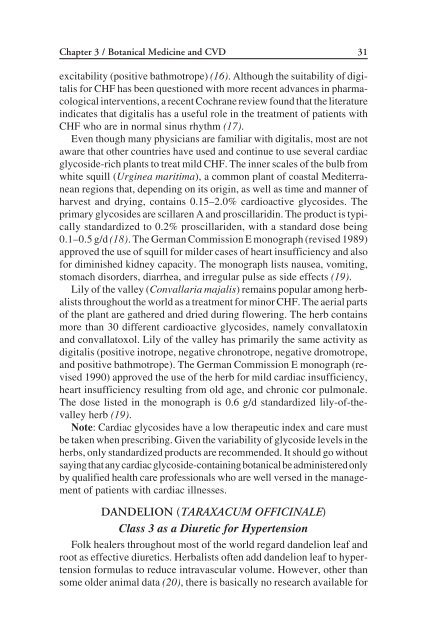Complementary Alternative Cardiovascular Medicine
Complementary Alternative Cardiovascular Medicine
Complementary Alternative Cardiovascular Medicine
Create successful ePaper yourself
Turn your PDF publications into a flip-book with our unique Google optimized e-Paper software.
Chapter 3 / Botanical <strong>Medicine</strong> and CVD 31<br />
excitability (positive bathmotrope) (16). Although the suitability of digitalis<br />
for CHF has been questioned with more recent advances in pharmacological<br />
interventions, a recent Cochrane review found that the literature<br />
indicates that digitalis has a useful role in the treatment of patients with<br />
CHF who are in normal sinus rhythm (17).<br />
Even though many physicians are familiar with digitalis, most are not<br />
aware that other countries have used and continue to use several cardiac<br />
glycoside-rich plants to treat mild CHF. The inner scales of the bulb from<br />
white squill (Urginea maritima), a common plant of coastal Mediterranean<br />
regions that, depending on its origin, as well as time and manner of<br />
harvest and drying, contains 0.15–2.0% cardioactive glycosides. The<br />
primary glycosides are scillaren A and proscillaridin. The product is typically<br />
standardized to 0.2% proscillariden, with a standard dose being<br />
0.1–0.5 g/d (18). The German Commission E monograph (revised 1989)<br />
approved the use of squill for milder cases of heart insufficiency and also<br />
for diminished kidney capacity. The monograph lists nausea, vomiting,<br />
stomach disorders, diarrhea, and irregular pulse as side effects (19).<br />
Lily of the valley (Convallaria majalis) remains popular among herbalists<br />
throughout the world as a treatment for minor CHF. The aerial parts<br />
of the plant are gathered and dried during flowering. The herb contains<br />
more than 30 different cardioactive glycosides, namely convallatoxin<br />
and convallatoxol. Lily of the valley has primarily the same activity as<br />
digitalis (positive inotrope, negative chronotrope, negative dromotrope,<br />
and positive bathmotrope). The German Commission E monograph (revised<br />
1990) approved the use of the herb for mild cardiac insufficiency,<br />
heart insufficiency resulting from old age, and chronic cor pulmonale.<br />
The dose listed in the monograph is 0.6 g/d standardized lily-of-thevalley<br />
herb (19).<br />
Note: Cardiac glycosides have a low therapeutic index and care must<br />
be taken when prescribing. Given the variability of glycoside levels in the<br />
herbs, only standardized products are recommended. It should go without<br />
saying that any cardiac glycoside-containing botanical be administered only<br />
by qualified health care professionals who are well versed in the management<br />
of patients with cardiac illnesses.<br />
DANDELION (TARAXACUM OFFICINALE)<br />
Class 3 as a Diuretic for Hypertension<br />
Folk healers throughout most of the world regard dandelion leaf and<br />
root as effective diuretics. Herbalists often add dandelion leaf to hypertension<br />
formulas to reduce intravascular volume. However, other than<br />
some older animal data (20), there is basically no research available for


